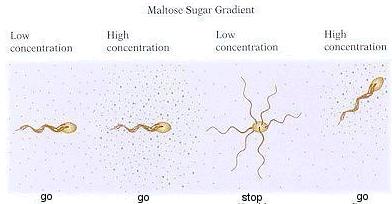The Brain functions illustrated
Nervous System
Return to neurotransmitter page Nervous System
Contents
Neurons and Nervesneurotransmitter
The Brain & Spinal Cord
Cranial Nerves
Peripheral Nervous System
Autonomic Nervous System
Senses:Eye diagrams,Hearing,Smell,Taste, Taste & Tongue Sensation,Balance
Memory , Memory types, Creation of Memory,
Higher Functions
Altered States
[Top]
The Brain
Brains exist because the distribution of resources necessary for survival and the hazards that threaten survival vary in space and time. There would be little need for a nervous system in an immobile organism or an organism that lived in regular and predictable environment. Brains are informed by the senses about the presence of resources and hazards; they evaluate and store this input and generate adaptive responses executed by the muscles. | Some of the most basic features of brains can be found in bacteria because even the simplest motile organisms must solve the problem of locating resources and avoiding toxins. They sense their environment through a large number of receptors, which are protein molecules embedded in the cell wall. The action taken in response to the inputs usually depends on the gradient of the chemicals (see Figure 03a). Thus memory is required to compare the inputs from different locations. The strength of the signal is modulated by immediate past experience. This in turn regulates the strength of the signal sent by chemical messengers from |
Figure 03a E. coli's Response to Chemical Gradient[view large image] | the receptor to the flagellar motors. Thus even at the unicellular level, the bacteria have already possessed the ability to integrate numerous analog inputs and generate a binary (digital) output of stop or go. |
Action potentials and voltage-gated sodium channels are present in jellyfish, which are the simplest organisms to possess nervous systems. The development of this basic neuronal mechanism set the stage for the proliferation of animal life that occurred during the Cambrian period. Among these Cambrian animals were the early chordates, which possessed very simple brains. Some of these early fish developed a unique way to insulate their axons by wrapping them with a fatty material called myelin, which greatly facilitated axonal transmission and evolution of larger brains. Some of their descendants, which also were small predators, crawled up on the muddy shores and eventually took up permanent residence on dry land. Challenged by the severe temperature changes in the terrestrial environment, some experimented with becoming warm-blooded, and the most successful became the ancestors of birds and mammals. Changes in the brain and parental care were a crucial part of the set of mechanisms that enabled these animals to maintain a constant body temperature.
Animals with large brains are rare -- there are tremendous costs associated with large brains (the active human brain consumes about 20 watts). The brain must compete with other organs in the body for the limited amount of energy available, which is a powerful constraint on the evolution of large brains. Large brains also require a long time to mature, which greatly reduces the rate at which their possessors can reproduce. Because large-brained infants are slow to develop and are dependent on their parents for such a long time, the parents must invest a great deal of effort in raising their infants. Young reptiles function as